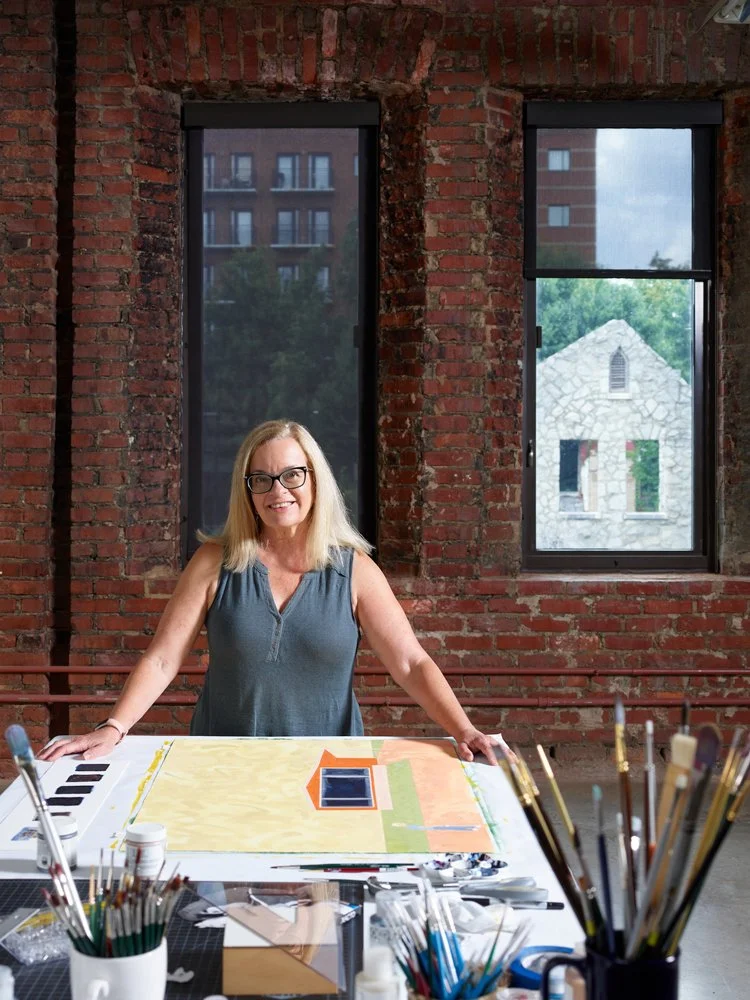Biography
photo: Chris Edwards
Barbara Schreiber’s works on paper appear lighthearted at first glance, but often have disturbing undertones.
Born in Baltimore MD, Schreiber was a Cold War baby. Her aesthetic was formed in part by dinner-table discussions of political brinksmanship, her upbringing in a gritty town, and the solace she found gazing at tiny, enameled antiquities at the Walters Art Museum and four small Cézanne paintings of Mt. St. Victoire at the Baltimore Museum of Art.
Schreiber’s exhibitions include the High Museum of Art, Southeastern Center for Contemporary Art, SPACE Pittsburgh, the Weatherspoon Museum of Art, Atlanta Contemporary Art Center, the Museum of Contemporary Art of Georgia, Telfair Museum of Art, Mint Museum of Art, American Academy and Institute of Arts and Letters, the Sorbonne, and numerous other spaces. She has completed residencies at Virginia Center for the Creative Arts, the Hambidge Center, McColl Center, Kimmel Harding Nelson Center for the Arts, and Goodyear Arts.
In addition to her work as an artist, Schreiber can sometimes be pestered into writing about visual art. Her articles, essays, reviews, and navel staring have appeared in Art Papers, Sculpture, Metalsmith, Creative Loafing Charlotte, The Atlanta Journal-Constitution, The Charlotte Observer, and other publications. She was an associate editor of Art Papers for ten years.
Schreiber attended Atlanta College of Art and received her BFA from Maryland Institute College of Art. She currently lives in Charlotte NC.
Schreiber’s work is filled with animals that sometimes serve as stand-ins for humans. In particular, she identifies with small, wild ones—adorable, understood by few, and ultimately alone in a complex, fast-moving world.
Résumé
Download Barbara's full résumé here.
Statement
I make paintings that are mournful, but colorful. They are small elegies, but leavened with hope and sometimes humor.
A little more than a decade ago, I began to make paintings set in the wildland-urban interface, where rampant residential development encroaches on native habitats and wildfire risk is high. These paintings usually depicted a single house in a spare landscape. Occasionally, the house was occupied by animals reclaiming the land that had been taken from them.
In 2017, after the death of my husband in a bicycle accident, my work became infused with personal loss. There were more fires with more meanings: grief, anger, purification, rebirth.
But a few months into the pandemic, I began painting crowds. These works were initially inspired by the absence of the casual crowds we took for granted in the pre-Covid era and the presence of the urgent, highly defined crowds that emerged during lockdown. At first, these crowds consisted only of plague doctors, but they eventually went on to include animals.
Recently, my work has changed again. Now, there are simply animals and plants, often arranged in quasi-decorative patterns and painted on papers that are cut into various shapes, often flames. For a six-month period, I painted almost nothing but birds falling out of the sky. My work has always combined the pretty picture and the difficult subject, and these paintings push that contrast further, with increasingly decorative depictions of increasingly dire situations.
There is no theory or academicism in my work. It is lived experience, observation, and catharsis.
